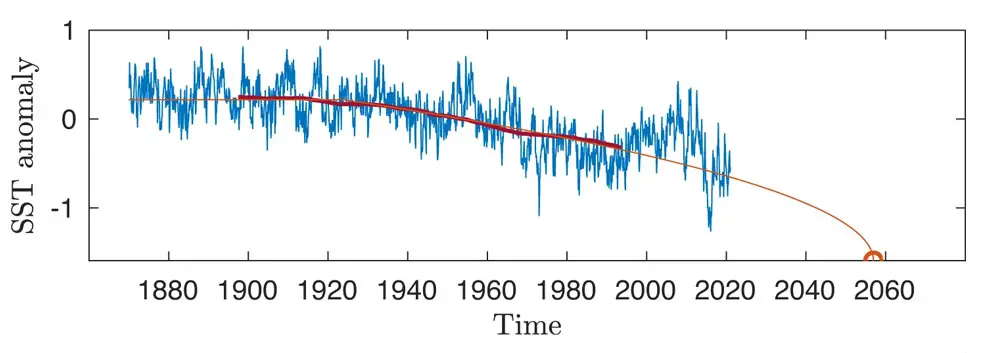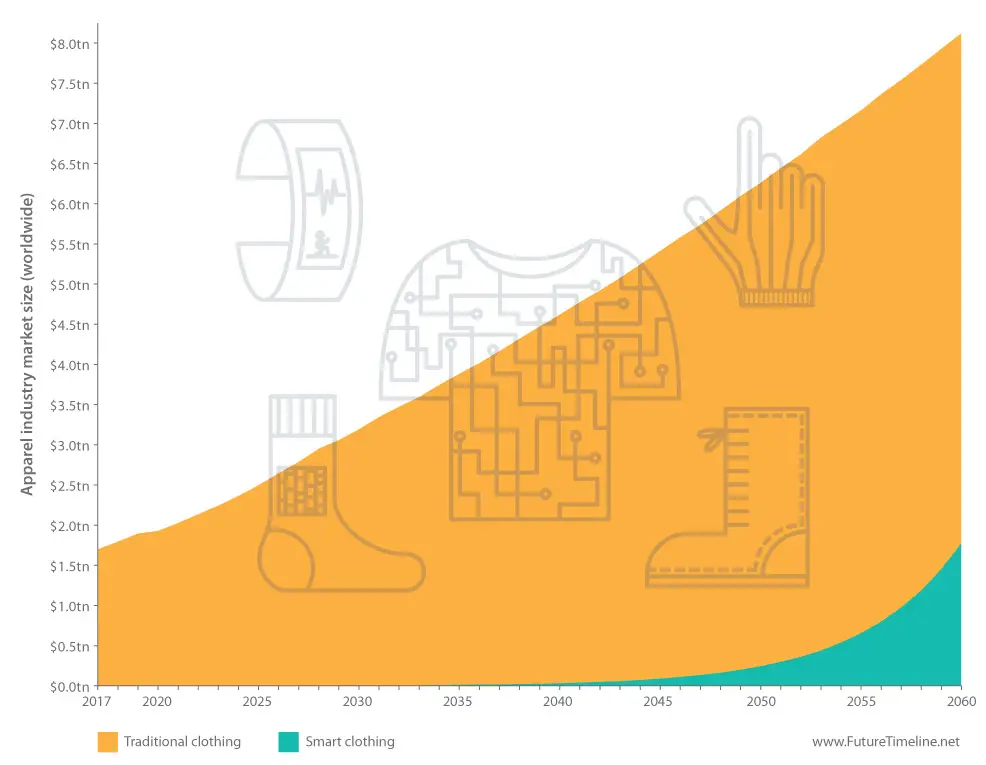
|
|
|
|
|
|
|
2057
Collapse of the Atlantic meridional overturning circulation (AMOC)
The Atlantic meridional overturning circulation (AMOC), part of the global thermohaline circulation (THC), is a large system of ocean currents. Driven by differences in temperature and salinity, it acts as a conveyor belt, bringing warm surface water from the tropics to the north, which then sinks to greater depths as colder and heavier salt water before returning south.
Throughout modern history, the AMOC had been a vital component of the global climate system. It maintained stable temperatures, giving Western Europe – including Britain with its latitude of around 55°N – relatively mild winters. It regulated rainfall patterns, such as the monsoons in West Africa, and supported marine ecosystems by distributing nutrients and oxygen.
During a period known as the Younger Dryas, which occurred circa 12,900 to 11,700 years BP, the AMOC experienced a weakening. Freshwater released from the melting of North American ice sheets, as well as the Greenland ice sheet and others, contributed to a reduction in salinity and density of the surface waters in the North Atlantic. The resulting disruption to ocean currents led to a slowdown of the AMOC, which caused Europe and North America to become much colder, by as much as 10°C (18°F) in some regions. Primarily affecting the Northern Hemisphere, this event lasted for 1,200 years and impacted early human populations, altering habitats and food availability.
During the modern era, scientists began to observe a similar weakening of the AMOC, this time caused by human-induced climate change, particularly the increased melting of the Greenland ice sheet.
The "fingerprint" of the AMOC's changing status could be traced back to the 1850s, when sea surface temperature anomalies first began to emerge within the subpolar gyre, although these deviations only became obvious much later. As the 20th century progressed, researchers detected more early-warning signals in water temperature and current data, such as increased variance (indicating a loss of resilience in the system) and autocorrelation (a critical slowing down).
By 2015, a large temperature anomaly – known in scientific circles as the "cold blob" – could be seen forming to the south of Greenland, where freshwater poured from land into the ocean.*
By the early 2020s, the AMOC had slowed by 15% compared to the mid-20th century,* its slowest point for at least 1,600 years,* and seemed to be trending towards a collapse at some point in the future. Researchers found its decline to be approximately 0.5 sverdrups (a million cubic metres per second, the standard unit for ocean circulation) per year, 10 times as fast as predicted by earlier climate models.
Indeed, previous studies by the Intergovernmental Panel on Climate Change (IPCC) found little or no risk of the AMOC undergoing a collapse before 2100. Following the appearance of the cold blob, however, subsequent research concluded that the IPCC had underestimated this potential.* One notable study in 2023 predicted with 95% confidence that such an event would occur at some point between 2025 and 2095, with a most likely date of 2057.*
Anomalies of temperature and current within the subpolar gyre continued into the 2030s and beyond. This AMOC fingerprint now indicated a severe loss of resilience in the system, with increasingly wild variations, in contrast to the stable and higher-frequency oscillations of the 19th and early 20th centuries.
Abrupt and non-linear changes began to emerge in the 2050s, portending a catastrophe in the near future. Today, in 2057, a complete shutdown of the Atlantic meridional overturning circulation is underway.*

Sea surface temperature (SST) anomaly within the Atlantic meridional overturning circulation (AMOC), 1870–2060. Credit: Peter Ditlevsen & Susanne Ditlevsen, Nature (2023).
The slowdown and collapse of the AMOC is one of the biggest, most devastating climate tipping points of the 21st century. Not only does it radically alter the climate of northwest Europe, it also disrupts many interlinked systems around the world.*
Although the global average temperature rise has recently surpassed 2°C,* a somewhat paradoxical development is occurring in some countries. Due to the loss of heat from the tropics – formerly delivered by the AMOC – parts of Britain and Scandinavia are now seeing exceptionally cold winters, far more reminiscent of the same latitudes in Canada, with temperatures plunging by several degrees Celsius.* The same reduction in warmth is seen in the high Arctic north of the Canadian Archipelago, as well as Greenland. In Western European countries, such as France, Germany, and Switzerland, the drop in temperature is less dramatic but still substantial at between 2 and 3°C (3.6–5.4°F). This change offsets much of the trend in global warming, although the benefit is relatively minor in the context of the many other aspects of climate change. Eastern Canada, meanwhile, is cooled by 1 to 2°C (1.8–3.6°F).
While some northerly parts of the planet are cooling, the Southern Hemisphere is now seeing increased heat. Latin America and the West African coast are being devastated by catastrophic additional warming of 2 to 3°C (3.6–5.4°F). Alongside this, the Intertropical Convergence Zone (ITCZ) has been shifted from just north of the equator to just south, resulting in double the usual precipitation at regions near 15° S latitude. At the same degree latitude north, precipitation levels have now decreased.
Due to the interconnectedness of climate systems, the collapsing AMOC has many ripple effects, extending to other parts of the world. Its variations can worsen the monsoons of India as well as West Africa, for example, and influence the atmospheric conditions contributing to El Niño Southern Oscillation (ENSO) events in the eastern tropical Pacific. There are even downstream effects on regions as distant as the Antarctic, where shifts in ocean salinity and heat distribution carried from the north can potentially impact sea ice extent and the stability of ice shelves.
Since it can no longer be transported to the Arctic Circle, warm water is now "piling up" in vast volumes along the Eastern Seaboard of the United States, contributing to a step change in sea level rise. New York and other cities on the coast are now preparing major flood defences. Conversely, the southern tips of South America and Australia are seeing a slight reduction in sea levels.
The British Isles – consisting of England, Scotland, Wales, Northern Ireland, Ireland, and nearly 200 smaller inhabited islands – are among the regions most seriously affected by the collapsing of the AMOC. Formerly a haven of relative stability, this part of the world is now undergoing significant political, economic and social disruption, with a semi-permanent state of emergency caused by extreme cold weather. Due to government cutbacks, the United Kingdom has fallen decades behind its target for home insulation* and energy efficiency, leaving it poorly prepared. To avoid thousands of excess deaths each winter, the use of "warm banks" is expanded for poorer and vulnerable groups, in public spaces such as community centres, churches, libraries, and art galleries.*
The impacts on food availability are less severe than they might have been in earlier decades, thanks to diversification and a rapid scaling up of alternative sources of production. This includes precision fermentation, cultured meats, hydroponics, and other indoor techniques. However, much of the world still relies on traditional crop growing and livestock farming, now under severe strain from climate change. Many overseas food products are therefore becoming unaffordable or subject to protectionism, as exporting nations struggle to feed their own people.
The United Kingdom and Ireland – which last had self-sufficiency in domestically-made food in the early 1800s – are now having to consider a reintroduction of food rationing for the first time since the early 1950s. In London, the River Thames is often completely frozen over for several weeks in winter, for the first time since 1814. This event had previously occurred during a period known as the Little Ice Age.*
The impacts of the AMOC's collapse go beyond just climatic changes. Human migration patterns are dramatically altered. As people from affected regions seek more hospitable climates or escape collapsing economies, Europe in particular faces an unprecedented influx of refugees. This mass movement is among the biggest challenges of the late 2050s.

Smart clothing is a trillion-dollar industry
"Smart" clothing and electronic textiles (or e-textiles) came to public attention in the opening years of the 21st century, with various items of apparel being demonstrated at the research and development stage, or as early consumer products. This form of wearable technology offered the potential to enhance a user's everyday experiences in ways that traditional fabrics could not.
Initially targeted primarily at health and fitness enthusiasts, smart clothing gradually expanded into other areas – including medicine and patient monitoring, fashion, entertainment and gaming/virtual reality, workplace applications and military uses.
It could generally be divided into two main categories: aesthetic and performance enhancing. Aesthetic examples included fabrics that lit up and fabrics able to change colour. Some of these fabrics gathered energy from the environment by harnessing vibrations, sound, or heat. Others worked by embedding the fabric with electronics to power it. Performance enhancing textiles, intended for use in athletic, extreme sports, and military applications, included fabrics designed to regulate body temperature, reduce wind resistance, and control muscle vibration.
Additionally, companies began to develop smart fabrics to guard against extreme environmental hazards, such as radiation and the effects of space travel. Innovations also included drug-releasing textiles, as well as fabrics for the health and beauty industry with moisturiser, perfume, and anti-aging properties.
The first generation of smart apparel had relatively modest capabilities – attaching a sensor to a garment or shoe, for example. The second generation had more advanced products with sensor(s) embedded within the garment. In subsequent generations, the garment itself became a sensor. A growing number of companies began to create flexible, stretchable, waterproof electronics with hydrophobic coatings able to repel water. Not only could these survive a laundry cycle or inclement weather, they also had wireless power inputs, without the need for any batteries.*
Progress with sensor technology, new materials, artificial intelligence (AI), motion tracking and haptics led to increasingly sophisticated products that increased the functionality and consumer appeal of smart clothing. While it remained a small fraction of the overall clothing market, a compound annual growth rate (CAGR) of 20% enabled smart clothing to gain ever more market share.*** This allowed it to expand into a multi-billion-dollar industry in the 2020s and reach an inflection point during the 2040s.
By the late 2050s, smart clothing has become a trillion-dollar industry and continues to see faster growth compared to traditional clothing. Almost everyone in the developed world now has at least one item of smart clothing. The technology is now so cheap that the developing world is catching up too, much like smartphones became ubiquitous globally in the 2010s. Some of the most common and popular items include garments able to continuously monitor a heart rate, breathing, and other vital signs, alerting a hospital or medical professional to the first hint of trouble and ensuring a wearer gets the care they need. Longer term conditions can also be monitored from data on the strength and geometry of movements, for example.
Other clothes feature embedded photovoltaics, serving as wearable power supplies. This is especially useful for camping trips or other excursions. In a world of higher temperatures due to climate change, smart clothing can also provide cooling capabilities.
Meanwhile, scientists in the field can touch samples and obtain genetic sequences in a matter of seconds, while forensic teams can investigate crime scenes and improve the gathering of evidence, using smart gloves.
The world of fashion is also transformed, with garments able to quickly change appearance and texture, depending on a wearer's preference. Some of the more advanced clothes even incorporate video or holographic displays, providing opportunities for striking designs. In addition to gaudy catwalk creations, this also includes subtler and less showy versions, such as on-person buttons, wrist interfaces, holographic watches and so on. Smart clothing is also used in retail, catering, entertainment and other venues – to generate name badges, for example, or change the appearance of a uniform.
Seemingly endless applications are now possible, thanks to ongoing advances in technology. Smart clothing has grown from being a small and niche segment of the market in earlier decades, to a common part of many apparel and footwear ranges in the 2050s. By the 2070s, the majority of clothing will be smart, as the world becomes ever more saturated with biometric and other data.

Handheld MRI scanners
The ability to scan, analyse and diagnose the body has taken a huge leap forward by now. Hi-res, 3D imaging of internal structures and brain activity is now possible using real-time video, rather than static photos. This can be accomplished with devices no bigger than a camera or tablet.* In the late 20th and early 21st century, these machines were so bulky that they filled whole rooms.* Scans typically required half an hour or longer to create. They were also expensive: upwards of a million dollars for a state-of-the-art
A new generation of machines began to evolve, based on supersensitive atomic magnetometers, detecting the tiniest magnetic fields. These replaced the enormous doughnut-shaped magnets used in the past. By the late 2050s, MRI scans have become as quick and easy as taking a photograph, with a hundredfold decrease in cost.* This is allowing healthcare programs in developing countries to benefit particularly.

« 2056 |
⇡ Back to top ⇡ |
2058 » |
If you enjoy our content, please consider sharing it:
References
1 Cold blob, Wikipedia:
https://en.wikipedia.org/wiki/Cold_blob
Accessed 6th August 2023.
2 Antarctic ocean heading for "collapse" by 2050, Future Timeline Blog:
https://futuretimeline.net/blog/2023/04/5-antarctic-ocean-collapse-2050.htm
Accessed 6th August 2023.
3 Climate crisis: Scientists spot warning signs of Gulf Stream collapse, The Guardian:
https://www.theguardian.com/environment/2021/aug/05/climate-crisis-scientists-spot-warning-signs-of-gulf-stream-collapse
Accessed 6th August 2023.
4 "Timing of the critical AMOC transition is still highly uncertain, but increasingly the evidence points to the risk being far greater than 10% during this century – even rather worrying for the next few decades. The conservative IPCC estimate, based on climate models which are too stable and don't get the full freshwater forcing, is in my view outdated now."
See What is happening in the Atlantic Ocean to the AMOC?, Real Climate:
https://www.realclimate.org/index.php/archives/2023/07/what-is-happening-in-the-atlantic-ocean-to-the-amoc/
Accessed 6th August 2023.
5 Warning of a forthcoming collapse of the Atlantic meridional overturning circulation, Nature:
https://www.nature.com/articles/s41467-023-39810-w
Accessed 6th August 2023.
6 Gloomy climate calculation: Scientists predict a collapse of the Atlantic ocean current to happen mid-century, University of Copenhagen:
https://science.ku.dk/english/press/news/2023/gloomy-climate-calculation-scientists-predict-a-collapse-of-the-atlantic-ocean-current-to-happen-mid-century/
Accessed 6th August 2023.
7 The Mother of All Tipping Points: AMOC Shutdown and Chaotic Connections to Earth Systems and Us, Paul Beckwith, YouTube:
https://www.youtube.com/watch?v=Nh1MbBmxOII
Accessed 6th August 2023.
8 See 2049.
9 Climate tipping points and their cascading effects, OECD iLibrary:
https://www.oecd-ilibrary.org/sites/abc5a69e-en/1/3/2/index.html?itemId=/content/publication/abc5a69e-en&_csp_=6d00888f3885b1fcadfb107c6ede4c51&itemIGO=oecd&itemContentType=book
Accessed 6th August 2023.
10 "The thinktank found substantial changes were [needed] to the scheme, because at current rates and under conservative assumptions, the government would not hit its target until 2091. In reality, it is more likely the goal would not be hit until the 22nd century, the IPPR said."
See Government 'will miss fuel poverty target by more than six decades', The Guardian:
https://www.theguardian.com/society/2018/jul/03/government-fuel-poverty-target-ippr-energy-efficiency
Accessed 6th August 2023.
11 Cost of living: What is a warm bank and which cities are they opening in?, ITV:
https://www.itv.com/news/2022-08-30/cost-of-living-what-is-a-warm-bank-and-which-cities-are-they-opening-in
Accessed 6th August 2023.
12 To clarify, a partial freeze occurred more recently, in the winter of 1963. Total freezing of the Thames last occurred in 1814.
13 Future washable smart clothes powered by Wi-Fi, Future Timeline Blog:
https://www.futuretimeline.net/blog/2021/06/10-smart-clothing-future.htm
Accessed 29th June 2021.
14 Smart Clothing (Wearable Tech) – Thematic Research, GlobalData:
https://store.globaldata.com/report/gdtmt-tr-s301
Accessed 29th June 2021.
15 Global Smart Clothing Market Will Accelerate Rapidly with Excellent CAGR in Future with top prominent players in this market, PharmiWeb:
https://www.pharmiweb.com/press-release/2021-05-04-279/
Accessed 29th June 2021.
16 Thematic Research into the Smart Clothing (Wearable Tech) Industry to 2023 - Featuring Adidas, Alphabet and Athos Among Others - ResearchAndMarkets.com, BusinessWire:
https://www.businesswire.com/news/home/20210628005421/
Accessed 29th June 2021.
17 "It's going to be an incredible tool. Fifty years down the road,
there could be small handheld MRI devices – like the tricorder in the
Star Trek television series – that enable us to see signals from molecules,
and there will be patterns for different diseases."
See Thinking outside the box on MRI, Medical Physics Web:
http://medicalphysicsweb.org/cws/article/research/30780
Accessed 17th October 2009.
18 A typical MRI machine of the early 2000s, Wikipedia:
http://en.wikipedia.org/wiki/File:Varian4T.jpg
Accessed 17th May 2014.
19 Physics
of the Impossible, by Michio Kaku:
http://www.amazon.com/Physics-Impossible-Scientific-Exploration-Teleportation/dp/0307278824/ref=sr_1_1?ie=UTF8&s=books&qid=1250029787&sr=1-1
Accessed 17th October 2009.
![[+]](https://www.futuretimeline.net/images/buttons/expand-symbol.gif)






